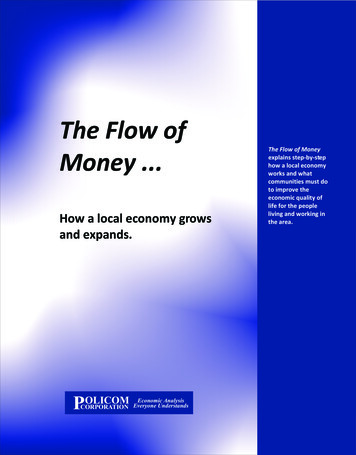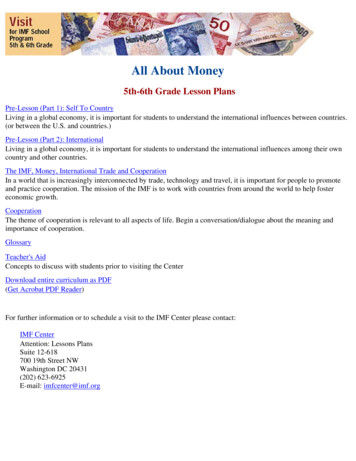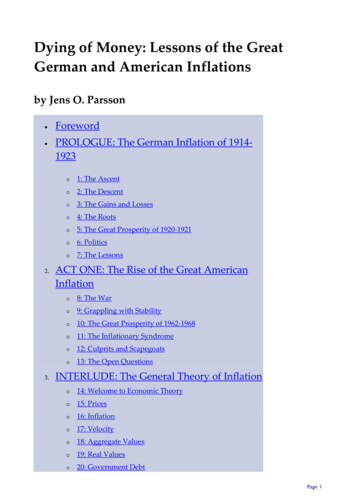
Transcription
The Flow ofMoney .How a local economy growsand expands.POLICOMEconomic AnalysisCORPORATION Everyone UnderstandsThe Flow of Moneyexplains step-by-stephow a local economyworks and whatcommunities must doto improve theeconomic quality oflife for the peopleliving and working inthe area.
POLICOMCORPORATIONEconomic AnalysisEveryone UnderstandsDear Community Leader:For the past twenty-two years, I have visited communities across the countrydetermining the condition of their economy and offering ideas on how to improveor maintain the situation.Some of these areas were growing and dynamic. Others were in significantdecline.Most of time, one of the main reasons an area was doing well was the result ofcommunity leadership. Local governments, civic, and business groups teamedtogether to implement an aggressive “economic development program.”Unfortunately, I also discovered one of the reasons an area was in economicdecline was the absence of the desire to do what was necessary to reverse whatwas happening. Oftentimes this was the result of not understanding what hadcaused the problem and what was needed to correct it.The Flow of Money has been written to assist community leaders inunderstanding the nature of their local economy. It presents the “basics” on whatevery community needs to do to cause a growing economy or to stop decline.It is hoped that after reviewing The Flow of Money, communities will embraceand put into action what is necessary to improve the economic quality of life forall the residents in their community.Sincerely,William H. FruthPresident2740 SW Martin Downs Blvd. #279, Palm City, FL 34990 - 772-781-5559 - www.policom.com - info@policom.com
Let us get started.You might have a brother, cousin or friend in another town or state who alwaysseems to brag about how good things are in their community while in your townit seems to be economically “dead.” Alternatively, you might be the one doing theboasting, as your area is growing, dynamic, and expanding.The difference, of course, is the condition of each “local” economy.Each day we hear on the news what is going on with the national economy.Unemployment might be up or retail sales down, nationally. However, nationaldata can have little resemblance to what is happening in the hundreds of localeconomies in the nation.As an example, for the five years from 2011 to 2016, the nation had a 1.9%average annual increase in jobs. However, among the 383 Metropolitan StatisticalAreas, only 6 had an average increase in jobs of 1.9% with 118 areas having fastergrowth and 259 areas slower.A local economycan behave muchdifferently thanwhat national datasuggests.During this period, Bend-Redmond, OR MSA employment grew at the annual rateof 5.5% and in the Sierra Vista-Douglas, AZ MSA jobs declined at the annual rateof 1.7%. Thirty-six areas lost jobs.The growth in annual earnings per job (wages) has the same disassociation fromnational data. Over the same five years, nationally wages increased an average of1.8%, but only 28 of the 550 Micropolitan Statistical Areas improved at thenational rate with 246 growing faster and 278 slower.The Findlay, OH Micropolitan Area improved a whopping 8.8% per year while theButt-Silver Bow, MT Micropolitan Area suffered an annual decline of 3.8%.The condition of the local economy affects people’s lives more than national dataor trends reflect.Why do some communities do better than others do? That is the billion-dollarquestion.The Flow of Money will help you understand how your local economy works, theflow of money into the area, the flow of money out, and what causes this tohappen.We will learn the difference between growing in size and growing in quality, andreview some of the characteristics of strong and weak economies.Finally, we will discuss what communities like yours need to do in order to createa robust, dynamic area, improving the standard of living for all the residents.So let us get started.1It is natural for peopleto resist change butsuch is inevitable.Communities canchoose to moveforward, embracingpositive change, oraccept the policy ofthose who want to donothing, preventingthe future from evervisiting theircommunity.
What is a local economy?Before we can discuss how your local economy influences the businesses andlives of the people who live in your area, it is important to first understand what alocal economy actually is.A local economy is simply a geographic area where a vast majority of the peoplelives and works. Within this area, which can be as small as a single county orinclude multiple counties, people earn their money and spend their money. Inessence, the area is a “contained” economy.For the most part, the geographic boundary of a local economy is determined bythe commuting patterns of the people in the area. The location and number of“jobs” within an area determines how big geographically the economy will be.Job centers are like magnets. They draw people toward them. Just like a magnet,the closer you are to it, the greater the pull of the force. The further away fromthe magnet, the less the draw until there is no force at all.The pull or draw of an employment center begins to diminish the further awaysomeone lives from its location. It boils down to how long it will take someone totravel to work each day.The extreme “reach” of an economy is approximately an hour. This isabout the limit a person is willing to commute for a job. In the UnitedStates, the average commuting time is about 26 minutes. However, avast majority of all economic activity occurs within 20 minutes of the“place of work” for an individual.Work In Fulton County (Atlanta), GA?Where do they live?11%Areas can have multiple magnets in different cities and counties,causing a maze of commuting throughout, consequently linking thecounties and cities “economically” even more. This is how “statisticalareas” form.The federal government defines “contained” economies based uponcommuting patterns.It has identified and designated 383Metropolitan Statistical Areas and 550 Micropolitan Statistical Areas inthe United States where a preponderance of the residents(approximately 75%) lives and works, earns and spends.15%Fulton CountyCobb CountyClayton County39%DeKalb CountyGwinnett CountyForsyth CountyOf the more than 1 million people whowork in Fulton County (Atlanta), GAonly 39% live in Fulton County.Metropolitan Statistical Areas (MSA) have at least one urbanized areaof 50,000 or more population, plus adjacent territory that has a highdegree of social and economic integration with the core as measuredby commuting ties. They must have at minimum one county and most of the timeincludes several counties.Micropolitan Statistical Areas (MICRO) are smaller areas. A Micropolitan Areamust have an urbanized area of at least 10,000 population but less than 50,000population. It must be at least one county. Most are a single county.28% 5% 3%
How a local economy works – the Flow of Money.Now that we know what a local economy is, we can discuss how it will grow ordecline.Imagine all of the wealth of a local economy is contained in a bucket. It swirlsaround and around, like being churned with a mixer. It goes from person-toperson, business-to-business, person-to-business, and is constantly moving.One person buys a house and a bank makes a loan. The Realtor buys a car. Theauto sales person buys a stereo. The storeowner makes a life insurance payment.The insurance agent pays school property taxes. The money moves on-and-onand-on.Money is like a hive of bees following the path of a three-dimensional spider web,moving from one point to another as it circulates throughout the economy.However, there is a hole in the bucket causing the wealth of the community toleak out.Every time you purchase an automobile, a good share of the purchase pricereturns to Detroit, Nashville, or Tokyo, or wherever the car was made. Every timeyou purchase a shirt, buy a pair of shoes, make your utility payment, go onvacation, pay your income taxes, money leaves the community and goes to thearea in which the product was made or the service performed.Money is continuously leaving the community through the hole in the bucket. Theoutward flow is constant, pervasive, and ongoing. Nothing can be done to stop it,no matter how small the hole.So what should be done? A community needs to add money to its economicbucket, replenishing its supply.A faucet at the top of the bucket needs to be turned on, filling it with fresh,rejuvenating wealth, which enables the churning process to continue.Money is imported to an area principally by the business activity of the “primary”or contributory industries located within the economy.A business that is a primary sells its goods or services outside the area, importingmoney to the local area.When a manufacturer ships and sells its products, money flows into the homecommunity. When a farmer sells grain, money flows into the home community.When an engineer designs a bridge in another state, money flows into the homecommunity. When a research firm secures a federal grant, money flows into thelocal area.3
When the primary business is paid for its goods or services, itsworkers are paid and the wealth enters the local economy. It isthen mixed and churned; it ripples and multiplies, until it iseventually consumed, drained through the hole in the bucket.The churning process of the wealth in the bucket generatesmost of the jobs for the residents within a community as goodsand services are consumed.For the most part, a business either contributes or consumes. Ifthe business is not dependent upon the local marketplace for itsrevenues, it is “primary” in nature, a wealth contributor.A vast majority of all businesses in an area are consumptive.This means they are dependent upon and use the moneyflowing into the area. They include most retail stores, servicecompanies, restaurants, banks, doctors and lawyers.Manufacturing is one of the sectors thatimports wealth to a community.Local government is a consumptive enterprise as it dependsupon local money. If you check which companies advertise inthe local newspaper, you will quickly get a list of consumptive,dependent businesses.Typically, about 25% of an area’s workforce is employed byprimary businesses with the balance working for consumptiveenterprises. For the most part, only about 5% of the businessesin an area are primary, the rest consumptive.A local economy, along with the consumptive businesses, willgrow or decline in direct proportion to the amount of moneybeing imported to the area by the primary businesses.Economic Impact – Churning in the Bucket.Retailing depends upon and consumes thewealth that is imported to a community.When a primary employer sells its products it has a positiveeconomic impact upon the area.The overall impact upon a local economy is based upon the wages paid, theamount of local support needed by the company (local purchases of products orservices), capital investment (taxes paid), and the potential for ancillarycompanies to be formed because of the presence of the business in thecommunity. The economic impact a primary enterprise has upon a communityvaries among industrial sectors.For example, an automobile assembly plant will likely employ about 1,500workers, piecing together parts to make the car. The cost of constructing thefactory including equipment could very well have been 2-3 billion and wages arevery high. For this sector, this is just the beginning.4
It is quite likely more than 50 other companies in close proximity employ another8,000 people.These companies are manufacturing the parts for assemblage or providingtechnical support. As a result, the assembly plant has a significant overalleconomic impact upon the local economy.A major insurance company that employs 1,500 workers has a differentimpact. The average wages are very high for this company as insuranceactuaries and corporate executives are compensated very well.However, this type of enterprise does not need very many supportcompanies, like the automobile manufacturer. Also, it will occupy a generaloffice building which costs much less than an auto factory which has to investhundreds of millions in machinery.While is it a very desirable business to have in a community, the overalleconomic impact is less than the automobile assembly plant.Continuing, a manufacturer of simple plastic products such as milk jugs ortubing requires few if any support companies and a relatively low skilled,low-wage workforce. While it contributes to the economy, the “ripple effect”or impact is much less than the first two examples.The Flow of Money chart shows the annual economic impact upon a localeconomy of a pharmaceutical manufacturer, which employs 500 people andpays an average wage of 67,500. 1As a result of this company being located in the community, about 1,938additional spin-off jobs (mostly consumptive) are created, 17,500,000 inlocal and state taxes collected, 109,000,000 in taxable retail salesgenerated, and 1,967 households are supported.The impact study is the mathematical calculations of the economic activityoccurring during the mixing and churning within the bucket of wealth.The economic impact by primary employers is not the same for all. Some do nothave as great of impact as our example company. Others have more.1The Flow of Money economic impact chart is based upon an actual economic impact study createdby POLICOM for a community located in Florida. Overall impacts vary among industrial sectors(pharmaceutical manufacturing has one of the highest multipliers). The amount of impact alsodepends upon the number of support industries in the area and rates of taxation.5
What is “economic strength?”“Economic strength” is the long-term tendency for an area toconsistently grow economically in both size and quality.Each year POLICOM Corporation ranks the 383 Metropolitan StatisticalAreas and the 550 Micropolitan Statistical Areas for economic strength.Twenty-three economic factors that reflect how consistently areas grewin size and quality over a twenty-year period are measured.The economic strength rankings are created to enable POLICOM tostudy the characteristics of strong and weak economies throughout theUnited States. From this research, POLICOM is better able torecommend to communities what individual areas need to do toimprove their local economy.The highest ranked areas have had rapid, consistent growth in both sizeand quality for an extended period.The lowest ranked areas have been in decline, sometimes rapidly, for anextended period.It is a characteristic of strong economies to create or maintain primaryindustry jobs, which pay a wage higher than their local average wage, whichimproves the quality of the economy.It is a characteristic of weak economies to either lose high-wage jobs, or create aplethora of low-wage jobs, which dilutes the quality of the economy.One of the most important features of the strongest areas is they have diversifiedeconomies for the most part. This means they have multiple primary industriesfilling their bucket of wealth. This provides a consistent flow of money into theeconomy even if one of the industries has a downturn. 2In what ways do local economies grow?Local economies are dependent upon bringing money into the area for economicgrowth. Money is imported principally by the business activity of the primaryindustries. The consistency of the economy is dependent upon how regular ordependable the flow occurs.The increase or reduction in the size of the economy is in direct proportion to theamount of money flowing into the local economy. The quality of the economy, orthe standard of living for the people, seeks the level of the wages paid by thecontributory businesses.2For the economic strength rankings for all statistical areas, please go to www.policom.com.6201812345678910Ten Strongest Metropolitan AreasAustin-Round Rock, TX (MSA)Napa, CA (MSA)Seattle-Tacoma, WA (MSA)Nashville-Davidson, TN (MSA)San Jose-Sunnyvale, CA (MSA)Indianapolis-Carmel, IN (MSA)Dallas-Fort Worth, TX (MSA)Salt Lake City, UT (MSA)Raleigh, NC (MSA)Denver-Aurora, CO (MSA)2018Ten Strongest Micropolitan Areas12345678910Bozeman, MT (McrSA)Lewisburg, PA (McrSA)Truckee-Grass Valley, CA (McrSA)Traverse City, MI (McrSA)Wooster, OH (McrSA)Andrews, TX (McrSA)Durango, CO (McrSA)Edwards, CO (McrSA)Kapaa, HI (McrSA)Dickinson, ND (McrSA)
Growth in Size or VolumeThere are several ways to measure the growth of the size of a local economy. Letus look at some of them.Remember the discussion on how money, once it enters the bucket of wealth, it ismixed and churned. The flow back and forth is the result of “transactions.” Whenyou buy a pair of shoes, there is a transaction. When yougo to the doctor, there is a transaction.Employment FactoredOne of the components of “economic impact” is the valueof all the transactions, which occur because of thepresence of a particular business enterprise in aneconomy.2200200018001600You have likely heard the term “gross domestic product”(GDP). This is the measure of all the transactions in theUnited States. Counties and cities also have a “grossproduct.”Gross and taxable retail sales are also a way to measurethe growth in the size of an economy. Retail sales areessentially the purchases made by consumers at the enduser level while transactions are the movement of all themoney in the 10099989796959493929190898887The dollar amount of transactions can become a verylarge number. The 500-job pharmaceutical manufacturercauses about 420,000,000 in transactions each year.1400STRMETSTRMICWKMICThe strongest economies have had rapidconsistent growth for a very long time.(Average of the ten strongest and weakest areas – 1987-2016.)Typically, taxable retail sales are about 20% of all transactions, but this variesfrom county to county and state to state. The 500-job manufacturer causes about 109,000,000 in taxable retail sales each year. As the volume of money increasesin the economy, there are more transactions, thus more taxable retail sales,which are of interest to local government.Economic growth, as it affects the people who live and work in an area, is oftenmeasured by the increase in the number of jobs and total worker earnings.Total worker earnings are all the wages and salaries paid and the profits of soleproprietor businesses. Worker earnings account for most of the money circulatingin the bucket, causing the vast majority of all of the transactions to occur.As worker earnings increase, the amount of transactions and gross retail salesalso increase.By increasing the number of jobs, those, which are unemployed, have theopportunity to earn and spend. In addition, employers now compete for the bestworkers, providing opportunities for all to improve themselves.7WKMET
The strongest economies in the nation have had a significant increase in thenumber of jobs and total worker earnings because of the growth of their primaryindustries.The weakest economies have had little growth in employment and some havefewer people working in the area than ten-years ago. For some weak areas, afteradjusting for inflation, they actually have fewer dollars in the economy than theydid twenty-five years ago.However, just creating jobs of any kind can actually hurt a local economy in thelong run. It is a myth that “any new job will help an area.” It is time to talk about“quality.”Growth in QualityThe quality of the economy is a reflection of the standardof living of the people residing and working in an area. It isthe amount of money earned by the individuals annually.Earl Nightingale, the famous writer and philosopher, wasfond of saying, “There is nothing more important thanmoney for the things money is intended.”% of USA Wages130%120%110%100%90%Money has purchased better housing, better food, warmerclothing, more leisure time, better health care, bettereducation, and a more secure retirement than poverty everhas.The type of primary industry jobs located in the economydetermines the quality of the economy. The average areawage will seek the level of, but cannot exceed, the wagespaid in the primary 302010099989796959493929190898887The amount of money an individual earns each year, for avast majority of the people, determines their lifestyle. Theannual wages in a local economy, therefore, reflect thequality of the economy.80%STRMETSTRMICWKMICThe strongest economies have improved inquality for the last 20 years.(Average of the ten strongest and weakest areas – 1987-2016.)If a local economy has a large number of primary employers, which employ highwage workers, the overall level or quality of the economy, including theconsumptive industries, will rise toward those wages.If the area is dominated by primary businesses, which pay low-wages, the overallquality will be pulled down to that level.In fact, the addition of low-wage primary jobs into a high-wage economy canactually hurt an area.8WKMET
Typically, a low-wage employer would not locate in a high-wage economy, as itsworkforce would not be available. But what if the employer “imported” the lowwage, low skilled workforce.Since this employer does not pay a wage sufficiently high enough to support ahousehold in a high-wage economy, the community will actually have to subsidizethis employer through increased property taxes (schools and county services),housing subsidies, and a host of other low-income programs.Because of the presence of individuals “willing to work for less,” the wages forexisting low-skilled jobs, such as retailing, will actually decline. In this case, theentry of a low-wage employer actually hurts, or brings down, a high-wageeconomy.The quality of this economy will begin to seek the level of the low-wageemployer, as it is an anchor pulling down the workforce to its level.However, if an area is weak, lackluster, or chronically distressed economicallywith high unemployment, the entry of the low-wage employer is welcome.In addition, when a moderate-wage employer enters a low-wage economy; itspresence will lift all other jobs in the area.How can we improve a local economy?What can communities do to improve the local economy, to increase the amountof money flowing within the area and improve the standard of living for thepeople who live and work in the community?It is very simple.Create more primary industry jobs, which pay a wage higher than the areaaverage wage.By doing this, more money will flow into the economy and the quality of theeconomy will improve over time.Not only will the wages for the workers enter the bucket of wealth, so will all thespending and taxes paid by the companies themselves.As a result, all businesses will grow, more taxes will flow to local governmentenabling more and better services, schools will improve, and socio-economicproblems will begin to fade.When a community increases the number of high-wage primary industry jobs, a“force” pulls up the bottom rung of the economic ladder, lifting all through aseries of wage and skill steps, improving the standard of living for most people.9As the quality of the economyimproves, so does theeconomic quality of lifefor the residents.
Suppose a new primary employer locates to the area and employs 200 workerspaying 65,000 per year. It will naturally draw its workforce from those employedat the 55,000 rung on the wage ladder (principally because of skill level). At thatpoint, the employers who pay 55,000 will replace the workers from those on the 45,000 level, who will be replaced by those on the 35,000 rung. The upwarddraw eventually pulls new people into the workforce.This “force” also causes part-time low paying retail and service jobs to fold intofull-time jobs at higher wage levels and with fringe benefits.The quality of the economy will continue to rise if the new primary jobs created inthe area pay a wage higher than the local average.However, the quality will regress, decline, or dilute if new primary jobs createdpay less than the area average.What is economic development?All of the discussion regarding how local economies work now brings us to“economic development.”Economic development is the process or activity, which is focused uponimproving the overall economic strength of a community and the economicquality of life for all of the residents in the area.Economic development differs from community development.Community development, while an important activity for an area, is designed torelieve or cure socio-economic problems within the community. The programassists a specific geographic section or economically distressed classof residents in the community.Programs, which eliminate urban blight, revitalize crime-riddenneighborhoods, or provide housing assistance to the poor arecommunity development activities. However, they are not economicdevelopment activities.A successful economic development program will improve thestandard of living for all the residents. Oftentimes, when successful,the need for community development programs begins to fade.There are three basic economic development programs, which focus directly oncreating primary industry jobs: 1) existing industry program, 2) attractionrecruitment program, and 3) start-up program.The Existing Industry Program fosters the retention and causes the expansion ofthe existing primary-contributory businesses in the community. It is the mostimportant yet least expensive of the three programs.10
Many communities have fallen into economic distress simply because theirexisting primary industries have reduced employment or left the area entirely.Many times the reason the company has curtailed itsoperation is the result of a reduction in its marketplace,foreign competition, or locally generated costs haveexceeded profitability.An existing industry program focuses on ways to reducethe costs to primary businesses as much as possible, thuscausing them to be as profitable as possible. Additionally, acommunity can help a company, especially smallercompanies; expand the market for its products or service.As profitability increases, the companies not only do notleave the area, but they expand and employ more people,creating economic growth.The secret to a successful existing industry program is tobuild trust between the primary employers and thecommunity at large. Because of this trust, the company will willinglycommunicate problems caused locally with community leaders, who, in turn,work to solve these issues.Few people realize that aside from market conditions, the most frequent reason acompany will leave one area and move to another is “local community attitude.”Essentially, if the community has treated a company poorly over a period ofyears, and this treatment has added costs to the operation, when it comes timeto expand or “retool,” the company will seek a community in which it can bemore profitable.The Attraction or Recruitment Program encourages new contributory companiesto locate in the area. The program is designed to increase the amount and qualityof money flowing into the area and to make the economy more consistentthrough diversifying the types of contributory businesses.A recruitment program is time consuming, expensive and results may take years.Yet, even for growing economies, the program is desirable if for no other reasonthan to offset the eventual curtailment of its existing companies. For areas, whichare in decline or lack diversity, recruitment is necessary.An Attraction – Recruitment Program is constructed in a similar fashion to themarketing program of most businesses. The following are the steps taken:1.2.3.Determine what you have to sell.Identify who wants to buy what you have to sell.Then, repeatedly, overall a long period, ask them to buy your product.11
Now, your product is not your “community.” Many people think it is. Most peoplebelieve that where they live is the best place in the world. They believe, since it isa great place to live, companies will move there. Sorry. This is not the case.What you have to sell is a geographic pinpoint that has certain economic assetsthat will cause a company to be profitable if it is located there. Therefore, whenyou “determine what you have to sell,” you are actually making an inventory ofthese assets.Every community has assets and liabilities relative to profitability for primaryenterprises. Some have more or less of each. Those with the most assets andfewest liabilities have the best chance to create a dynamic economy.In order to “identify who will want to buy what you have to sell,” you need toexamine the various industrial sectors to determine what types of companiesneed your assets and can cope with your liabilities. You market to thesecompanies.The Start-Up Program is necessary to cause the creation of new contributorycompanies, which have a chance to grow and develop as the years pass.Several communities in the United States have created dynamic economies by“growing their own” primary businesses. By assisting and coaching imaginativeentrepreneurs, an idea can grow into a thriving business. Dell Computer was oncea “Start-Up” company.The visible and financial rewards to the community of such a program are in thefuture. Patience is required.Essentially, a Start-Up Program assists a local person who has an idea for a newproduct or service, which can be marketed outside the area (primary). Most ofthe time the individual does not have the financial resources or the knowledge totake this “great new idea” from a great thought to a great product. This iswhere the community comes in.The community has a team of professionals ready to guide the individualthrough the process of determining if the idea has merit, the development ofthe product, and the eventual marketing of the product. Usually a building(incubator) is needed along with venture, investment capital to convert theidea into an
The Flow of Money will help you understand how your local economy works, the flow of money into the area, the flow of money out, and what causes this to happen. We will learn the difference between growing in size and growing in quality, and review










